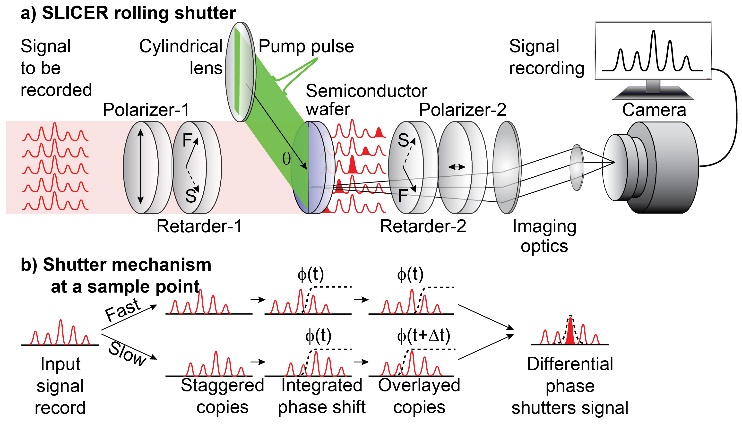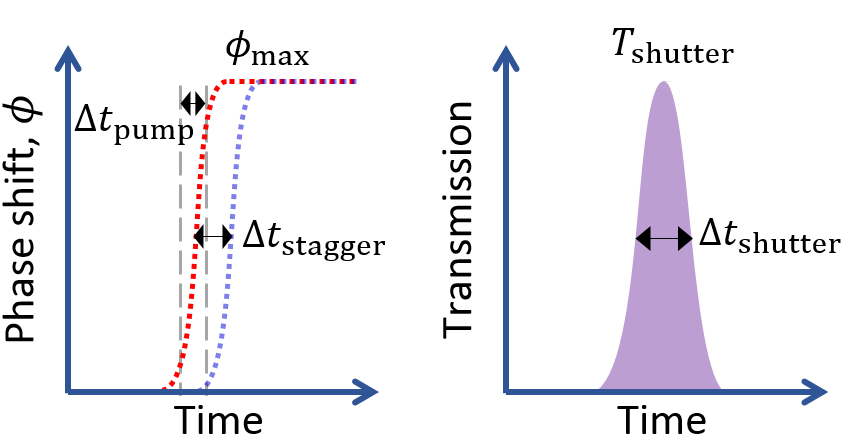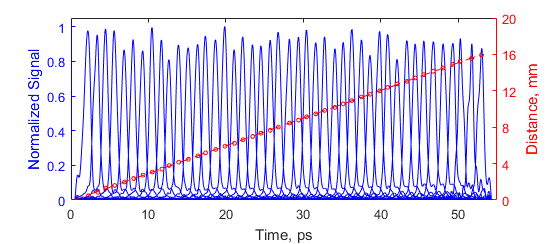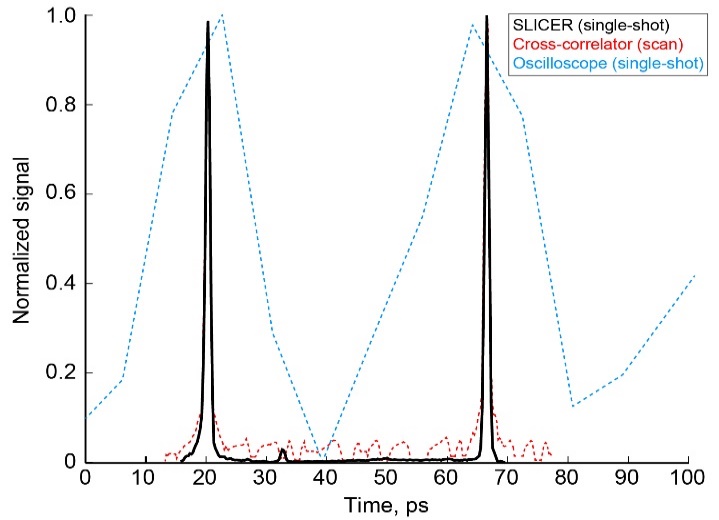John Heebner (15-ERD-055)
Abstract
Ultrafast, single-shot recording technologies are an essential capability for many experimental programs at Lawrence Livermore. Unfortunately, the timescales associated with important experimental signatures have outpaced the temporal resolution of these technologies. Experimenters deal with a time gap between commercially available oscilloscopes capable of long record lengths, and ultrafast optical techniques capable of subpicosecond resolution. No current technologies can deliver picosecond resolution across long record lengths. Many previous research and development efforts to build advanced recording technologies in this parameter space have demonstrated leaps in performance. These complex systems have achieved excellent results, but have not found widespread use due to challenges associated with their manufacturability or spectral versatility.
The goal of this project was to develop and demonstrate an advanced recording capability that bridged the picosecond-to-nanosecond time gap that is spectrally versatile. The proposed recording technique required a semiconductor wafer, a slanted incidence pump laser to gate the incoming signal’s time history as a function of space, and an ordinary camera to image the spatial distribution. The arrangement effectively mapped the temporal content of the signal across a lateral dimension of the camera for recording. Successful demonstration of this technique directly benefits the National Ignition Facility (NIF) advanced radiographic capability (ARC) programmatic mission, and is of interest to government contractors and commercial suppliers of high-speed instrumentation.
Background and Research Objectives
Previously demonstrated single-shot recording techniques include the following:
- Time lens methods (Bennett et al. 1994; Azaña 2003; Foster et al. 2008; Okawachi et al. 2012; Hernandez et al. 2013)
- Frequency resolved optical gating (FROG) (Wong and Trebino 2013; Bowlan and Trebino 2010)
- Spectral interferometry (Bowlan et al. 2006; Fontaine et al. 2011)
- Temporal holography (Nuss et al. 1994)
- Time stretch (Coppinger et al. 1999; Han and Jalali 2003)
- Spectral phase interferometry for direct electric field reconstruction (SPIDER) (Iaconis and Walmsley 1998)
- Phase diversity (Dorrer et al. 2015)
- Various others (Walmsley and Dorrer 2009; Trebino 2000).
Cross-correlators have appeal because they directly sample the intensity of a signal, require minimal post-processing, and can be displayed in real time. Many single-shot, cross-correlators have been demonstrated based on crossing pump-probe geometries enabling an ordinary camera to record spatially the time content of a signal (Wyatt and Marinero 1981; Jovanovic et al. 2007; Dorrer et al. 2008; Wang et al. 2014). Second-order X(2) nonlinearities are typically employed to enable a short pulse (pump) to sample a signal (probe) by sum frequency generation. Because of their ultrafast response, these sampling mechanisms are optimal for achieving time resolution limited primarily by the pump pulse duration. However, because time-of-flight at the speed of light dictates the mapping of time to space, extending these techniques to long record lengths proved to be challenging. The primary challenges resulted from the limited apertures of commercially available X(2) crystals, stringent phase-matching requirements, demanding spectral and angular requirements for the pump beam, and complexities associated with employing pulse-front tilt or etalon replicators.
It was desirable to identify a sampling mechanism that could overcome these challenges. Optical sampling based on the X(3) intensity-dependent refractive index (i.e., the Kerr effect) was implemented in many ultrafast interferometric switches, but due to the weak strength of the effect, it demanded impractically high peak intensities or long interaction lengths. In contrast, semiconductor nonlinearities resulting from optically-excited carrier-based changes to the refractive index can be a million times stronger. While the carriers can be rapidly excited to the conduction band at sub-picosecond timescales, their usefulness in short pulse applications was typically limited by their long persistence resulting from recombination times lasting several nanoseconds. We described a novel technique that enabled access to the strong index changes in semiconductors while achieving sub-picosecond resolution by optically differentiating their integrating response (Muir and Heebner 2017). This gating mechanism is analogous to the mechanisms used in the terahertz optical asymmetric demultiplexer (Tang and Shore 1999) and symmetric mach zehnder interferometer switches (Tajima 1993), and followed the spirit of previous work on semiconductor nonlinearities for optical recording, including the serrated light illumination for deflection-encoded recording (SLIDER) chipscale deflector (Sarantos and Heebner 2010) and synchronously coupled anamorphic light pulse encoded laterally (SCALPEL) chipscale interferometer (Shih et al. 2011). We named the technique slanted light interrogation for cross-correlated encoded recording, or SLICER.
The goal of this work was to develop a 1053-nm optical recorder based on a semiconductor nonlinearity with less than 1 ps resolution over a greater than 50 ps record length. The experimental demonstration achieved 0.5 ps resolution with 54 ps record length, and there is now a technical path forward toward achieving much longer records.
Scientific Approach and Accomplishments
Figure 1a illustrates the SLICER recorder architecture. By pumping the semiconductor with the line focus of a cylindrical lens at a slanted incidence angle, we achieved a rolling interferometric shutter. This enables a mapping of the signal’s time history to a spatial trace recorded on a camera imaging the wafer plane.
Optically pumping a semiconductor generated carriers, which induced a local change in the refractive index. There were many mechanisms in semiconductors that resulted in an index change from optically excited carriers, including band filling, bandgap shrinkage, and Drude plasma refraction (Bennett et al. 1990). For silicon, the Drude model was proposed as the dominant mechanism influencing the induced refractive-index change from the unpumped value of 3.4 (Soref and Bennett 1987). The total phase induced on a beam that traversed a pumped region of the wafer was proportional to the generated carrier density, and thus to the pump fluence.
After pumping the semiconductor with an ultrafast pump pulse, the generated carriers remained in the conduction band for time durations much longer than 1 ns. To achieve a short time-gating function, we probed the pumped region with two staggered copies of the signal to effectively differentiate the integrating phase response. As illustrated in Fig. 1b, two staggered copies of the signal beam were created along orthogonal polarization axes with a birefringent retarder. The copies probed the pumped region of the semiconductor and incurred equivalent integrated phase shifts, albeit with a staggered time shift. After traversing the semiconductor, a second identical birefringent retarder oriented orthogonally to the first ensured that the copies were again overlapped in time. Finally, a crossed polarizer was adjusted to null the resulting interference. Thus, for early and late times, the copies interfered destructively, leading to zero light transmission. This lead to a pump-induced transient differential phase shift that opened a brief sampling window for the signal, as illustrated in Figure 2. Figure 2 also shows that the shutter response resulting from the brief differential phase could be characterized by a maximum transmission and a full width half maximum (FWHM) temporal width.
To demonstrate the SLICER proof-of-concept, we constructed a testbed using a Lumentum GLX-200 mode-locked oscillator and a home-built Nd:glass chirped-pulse regenerative amplifier at 1053 nm that provided compressed pulse widths of 0.7 ps. Part of the regen output was kept as a test signal pulse while the remainder was harmonically doubled to 527 nm to create a 240 μJ, 0.5 ps pump pulse. The linearly polarized signal was sent through a 1-cm-thick quartz birefringent retarder at 45 degrees to create a pair of orthogonally polarized signal copies staggered in time by 0.3 ps. The signal was collimated and directed to be normally incident on a silicon wafer. The pump beam was focused to a 10-micron height by approximately 20 mm stripe width on the silicon wafer surface using a 1 m uncoated cylindrical lens slanted to be parallel to the silicon wafer. Due to the slant of the lens, its effective focal length was reduced to 700 mm. The p-polarized pump was shone onto the wafer, resulting in a mapping of time to space at a projected phase velocity of c/sin X, or 1.08 c. The plane of the wafer was imaged onto a camera (Princeton Instruments 16-bit Pixis-100).
To demonstrate the record length and uniformity of SLICER, a single impulse was scanned using a delay stage across the record in 1.2-ps steps across a useable record length of 54 ps. Each step was averaged across 50 measurements to reduce noise. Noise was due in part to shot-to-shot fluctuations in the laser source, causing instability in the focused pump stripe height. The data were calibrated using a previously collected dataset (Figure 3). The linearity of the time-to-space mapping is also shown in Figure 3 as the linearly-fitted centroid of each Gaussian pulse. The camera trace was effectively mapped to 0.25 ps per pixel, corresponding to a sampling rate of 4 terasamples per second for the recording system.
We then tested the single-shot capability of SLICER by recording a double-pulse test pattern and comparing its performance with two other conventional diagnostics. We implemented a Michelson interferometer to create two pulses 46 ps apart. Figure 4 displays the traces (in black) recorded with SLICER. For comparison, we measured the same signal (in red) using a homebuilt, multi-shot scanning X(2) cross-correlator (pumped using the same source) and (in blue) a fast photodiode (Discovery Semiconductors DSC-10) and oscilloscope (LeCroy Wavemaster 845-ZI 45GHz). The techniques were in close agreement, though the autocorrelator required a 15-minute scan, and the real-time photodiode trace does not achieve comparable resolution.
Table 1 compares the results of the three overlaid traces. For all techniques, the pulse durations were analytically inferred from the raw data. For the SLICER measurement, the effective shutter resolution benefited both from harmonic doubling and the shutter response.
While the demonstrated system had a significant advantage in simplicity, it required 200 μJ of pump energy. As with any tilted pulse front cross correlator, there was a 1/N sampling efficiency, where N was the number of resolvable spots in the record. The energy requirement could be lowered by focusing the pump stripe height even tighter, or by leveraging bandfilling and bandgap-shrinkage mechanisms in alternate semiconductors (Bennett et al. 1990). Additionally, we projected that the record length could be increased significantly by implementing pulse-1front tilt from a diffraction grating.
To our knowledge, our demonstration of 0.4 ps resolution over a 54 ps record was a record for this combination of sampling resolution and record length in a single-shot optical recorder. The resolution could be made finer with a shorter pump pulse, with the resolution limit ultimately governed by the carrier excitation rise time. There were no significant physics limitations to further scaling the record length that could be significantly increased by a) directly implementing large, commercially available semiconductor wafers, b) employing a pulse front tilted pump beam, and/or c) using the second dimension of the camera to stitch together staggered sub-records on separate rows of pixels. Through the addition of a spectrometer behind the SLICER device, the second dimension of the camera could also be used to record the spectrogram of the signal on a single-shot—its instantaneous frequency or wavelength versus time. If desired, the signal’s temporal phase could be extracted from either this spectrogram recording, or from an interferogram generated with an auxiliary reference pulse or self-referenced in a shearing geometry.
Impact on Mission
The work performed aligns with the Lawrence Livermore strategic focus areas in stockpile stewardship and inertial fusion energy. It further aligns with the institutional scientific capability portfolio investment strategy in the areas of:
- Positioning the programs for the future. A significant gap exists between emerging requirements and existing recording capabilities. The ARC upgrade for NIF currently has no direct means of recording the compressed pulse with sufficient record length (greater than 50 ps with sub-picosecond resolution on a single-shot basis at 1053 nm).
- Developing core competencies in laser and optical science and technology and high-energy-density science—particularly in the area of ultrafast diagnostics.
- Attracting the best and brightest talent and creating new opportunities for external interest, as well as licensing of already granted and possibly new intellectual property.
Conclusion
We demonstrated a novel single-shot optical-recording technique that directly measured the intensity of a pulsed waveform, required minimal post-processing, and could be displayed in real time. This had several advantages including making use of large and inexpensive semiconductor wafers, eliminating the need for phase matching, creating a broad insensitivity to the spectral and angular properties of the pump, and simplifying overall hardware. This enabled a simple slanted-incidence pump beam to be used for the time-to-space mapping. By contrast, X(2) based single-shot, cross-correlators required stringent angle and phase matching requirements, usually demanding more complex pulse front tilted pump beams or etalon replicators. The requirements on the pump beam’s quality, wavelength, and coherence were further relaxed, requiring only that the pump be focusable to sufficient fluence and absorbing in the semiconductor. The technique was extendable to longer record lengths by implementing pulse-front tilt. Finally, the technique was extendable to other wavelengths, semiconductors, and broadband signals of over 100 nm, requiring only that the pump/signal photon energies be above/below the bandgap energy of the material, respectively.
These conclusions will continue to be used in projects at Lawrence Livermore National Laboratory. They are currently being used in the STACCATO Optical Arbitrary Waveform Generator project to measure generated waveforms. Plans to implement this on ARC as a single shot pulse shape diagnostic have been developed. Additionally, we are working with the Laboratory's Industrial Partnerships Office to license this technology.
References
Azaña, J. 2003. "Time-to-Frequency Conversion Using a Single Time Lens." Optics Communications 217 (1-6): 205—209. doi: 10.1016/s0030-4018(03)01113-1.
Bennett, B. R., et al. 1990. "Carrier-Induced Change in Refractive Index of InP, GaAs and InGaAsP." IEEE Journal of Quantum Electronics 26 (1): 113—22. doi: 10.1109/3.44924.
Bennett, C. V., et al. 1994. "Temporal Magnification and Reversal of 100 Gb/s Optical Data with an Up‐Conversion Time Microscope." Applied Physics Letters 65 (20): 2513—2515. doi: 10.1063/1.112620.
Bowlan, P. and R. Trebino. 2010. "Single-Shot Frequency-Resolved-Optical-Gating Device for Completely Measuring Nanosecond Laser Pulses in Time," Frontiers in Optics 2010/Laser Science XXVI. doi: 10.1364/fio.2010.pdpb4.
Bowlan, P., et al. 2006. "Crossed-Beam Spectral Interferometry: A Simple, High-Spectral-Resolution Method for Completely Characterizing Complex Ultrashort Pulses in Real Time." Optics Express 14 (24): 11892—11900. doi: 10.1364/oe.14.011892.
Coppinger, F., et al. 1999. "Photonic Time Stretch and its Application to Analog-to-Digital Conversion." IEEE Transactions on Microwave Theory and Techniques 47 (7): 1309—1314. doi: 10.1109/22.775471.
Dorrer, C., et al. 2008. "High-Dynamic-Range, Single-Shot Cross-Correlator Using a Pulse Replicator." Proceedings of the 2008 Conference on Lasers and Electro-Optics. doi: 10.1109/cleo.2008.4552198.
——— 2015. "Single-Shot High-Resolution Characterization of Optical Pulses by Spectral Phase Diversity." Optics Express 23: 33116—33129. doi: 0.1364/OE.23.033116.
Fontaine, N. K., et al. 2011. "One Million Time-Bandwidth Product Full-Field Waveform Measurement using Frequency-to-Time Interferometry." CLEO:2011 - Laser Applications to Photonic Applications. doi: 10.1364/cleo_si.2011.ctuh6.
Foster, M. A., et al. 2008. "Silicon-Chip-Based Ultrafast Optical Oscilloscope." Nature 456, 81—84. doi: 10.1038/nature07430.
Han, Y. and B. Jalali. 2003. "Photonic Time-Stretched Analog-to-Digital Converter: Fundamental Concepts and Practical Considerations." Journal of Lightwave Technology 21 (12): 3085—3103. doi:10.1109/jlt.2003.821731.
Hernandez, V. J., et al. 2013. "104 MHz Rate Single-Shot Recording with Subpicosecond Resolution Using Temporal Imaging." Optics Express 21 (1): 196—203. doi: 10.1364/oe.21.000196.
Iaconis, C. and I. A. Walmsley. 1998. "Spectral Phase Interferometry for Direct Electric-Field Reconstruction of Ultrashort Optical Pulses." Optics Letters 23 (10): 792. doi: 10.1364/ol.23.000792.
Jovanovic, I., et al. 2007. "High-Dynamic-Range, 200-ps Window, Single-Shot Cross-Correlator for Ultrahigh Intensity Laser Characterization." Proceedings: 2007 Quantum Electronics and Laser Science Conference. doi: 10.1109/qels.2007.4431082.
Muir, R. D. and J. E. Heebner. 2017. "Single-Shot Optical Recording with Sub-Picosecond Resolution Implementing a Differentiated Semiconductor Nonlinearity." Conference on Lasers and Electro-Optics. doi: 10.1364/cleo_si.2017.stu4i.1.
Nuss, M. C., et al. 1994. "Time-to-Space Mapping of Femtosecond Pulses." Optics Letters 19 (9): 664—666. doi: 10.1364/ol.19.000664.
Okawachi, Y., et al. 2012. "Asynchronous Single-Shot Characterization of High-Repetition-Rate Ultrafast Waveforms Using a Time-Lens-Based Temporal Magnifier." Optics Letters 37: 4892—4894.
Sarantos, C. H. and J. E. Heebner. 2010. "Solid-State Ultrafast All-Optical Streak Camera Enabling High-Dynamic-Range Picosecond Recording." Optics Letters 35 (9): 1389—1391. doi: 10.1364/ol.35.001389.
Shih, T. M., et al. 2011. "Chipscale, Single-Shot Gated Ultrafast Optical Recorder." Optics Express 20 (1): 414—425. doi: 10.1364/oe.20.000414.
Soref, R. and B. Bennett. 1987. "Electrooptical Effects in Silicon." IEEE Journal of Quantum Electronics 23 (1): 123—129. doi: 10.1109/jqe.1987.1073206.
Tajima, K. 1993. "All-Optical Switch with Switch-Off Time Unrestricted by Carrier Lifetime." Japanese Journal of Applied Physics 32, Part 2 (12A). doi: 10.1143/jjap.32.l1746.
Tang, J. M. and K. A. Shore. 1999. "Analysis of the Characteristics of TOADs Subject to Frequency-Detuned Control and Signal Picosecond Pulses." IEEE Journal of Quantum Electronics 35 (11): 1704—1712. doi: 10.1109/3.798095.
Trebino, R. 2000. Frequency-Resolved Optical Gating: The Measurement of Ultrashort Laser pulses. Boston, MA: Kluwer. doi:10.1007/978-1-4615-1181-6.
Walmsley, I. A. and C. Dorrer. 2009. "Characterization of Ultrashort Electromagnetic Pulses." Advances in Optics and Photonics 1 (2): 308-437. doi: 10.1364/AOP.1.000308.
Wang, Y. Z., et al. 2014. "Single-Shot Measurement of >1010 Pulse Contrast for Ultra-High Peak-Power Lasers." Scientific Reports 4, article number: 3818. doi: 10.1038/srep03818.
Wong, T. C. and R. Trebino. 2013. "Single-Frame Measurement of Complex Laser Pulses Tens of Picoseconds Long Using Pulse-Front Tilt in Cross-Correlation Frequency-Resolved Optical Gating." Journal of the Optical Society of America B 30 (11): 2781—2786. doi: 10.1364/josab.30.002781.
Wyatt, R. and E. E. Marinero. 1981. "Versatile Single-Shot Background-Free Pulse Duration Measurement Technique, for Pulses of Subnanosecond to Picosecond Duration." Applied Physics 25 (3): 297—301. doi: 10.1007/bf00902986.
Publications and Presentations
Muir, R. D. and J. E. Heebner. 2017a. “Single-Shot Optical Recorder with Sub-Picosecond Resolution and Scalable Record Length on a Semiconductor Wafer." Optics Letters 42 (21): 4414—4417. doi: 10.1364/OL.42.004414. LLNL-JRNL-729266.
   









